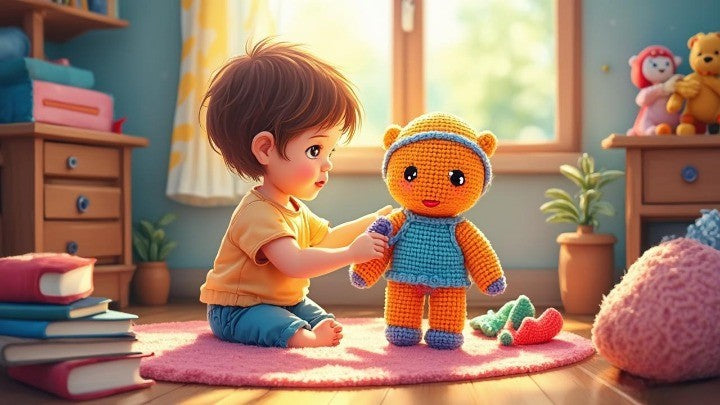
The Developmental Benefits of Handmade Crochet Dolls for Early Childhood
Share
n a world dominated by plastic toys and digital screens, the simple handmade crochet doll offers surprising developmental advantages for children from infancy through early elementary years. These artisan-created companions aren't just adorable playthings—they're powerful educational tools that support multiple aspects of early childhood development. Let's explore how these handcrafted amigurumi dolls contribute to your child's cognitive, sensory, emotional, and social growth.
Sensory Development (0-2 Years)

Tactile Exploration
The varied textures of crochet dolls provide rich sensory experiences crucial for infant brain development. Unlike smooth plastic toys, the woven texture of crochet creates a tactile landscape that stimulates a baby's developing sense of touch. This sensory input helps build neural pathways essential for brain development.
Visual Stimulation
Brightly colored crochet dolls with contrasting elements capture an infant's attention and help develop visual tracking skills. Babies as young as three months begin focusing on faces, making detailed crochet faces particularly engaging for early visual development. The defined stitches and varied textures provide visual complexity that mass-produced toys often lack.
Safe Oral Exploration
When made with baby-safe materials, crochet dolls offer appropriate mouthing opportunities—a crucial sensory exploration stage. The textured surface provides gum stimulation for teething babies, while the squishable nature makes them comfortable to hold and manipulate.

Motor Skills Development (1-4 Years)
Fine Motor Development
As toddlers interact with crochet dolls, they practice grasping, manipulating, and exploring with their hands. Small details like braided hair, button eyes (securely attached), or removable accessories provide opportunities for developing pincer grasp and finger dexterity—skills that later support writing readiness.
Dressing and Undressing Practice
Crochet dolls with simple removable clothing offer valuable opportunities for practicing fine motor skills. The act of dressing and undressing dolls helps children master clothing fasteners like buttons and snaps, building independence in self-care skills.
Language and Cognitive Development (2-5 Years)
Storytelling Catalyst
Crochet dolls serve as perfect props for storytelling, encouraging language development through imaginative play. Children naturally create narratives around their dolls, practicing vocabulary, sentence structure, and sequential thinking. Parents can promote this by asking open-ended questions about what the doll is doing or feeling.

Concept Development
Dolls with specific themes or characteristics introduce important concepts like community helpers, family relationships, or cultural diversity. A collection of personalized crochet dolls representing different professions, for example, can spark conversations about community roles and responsibilities.
Memory and Pattern Recognition
The distinctive features of handmade crochet dolls help children practice descriptive language and develop observation skills. Children learn to recognize and describe patterns, colors, and unique characteristics, building cognitive mapping skills that transfer to other learning domains.

Social-Emotional Development (3-8 Years)
Emotional Regulation
Crochet dolls often become "comfort objects" that help children manage big emotions. The soft, huggable nature of these dolls provides sensory regulation during upset moments, while their personalized features create a sense of connection that can ease transitions or anxieties.
Empathy Building
Through pretend play with dolls, children practice caring behaviors and develop empathy. Nurturing a doll teaches responsibility and sensitivity to others' needs—foundational skills for healthy relationships. This nurturing play is particularly valuable for preschoolers developing theory of mind (understanding others have different thoughts and feelings).
Cultural Identity and Diversity
Customized crochet dolls representing different cultures, abilities, or family structures help children develop inclusive perspectives. When children see diversity represented in their toys, they build appreciation for human differences and similarities from an early age.
Creative Expression (4-8 Years)
Imaginative Play
The simple design of crochet dolls leaves room for children to project their imagination, unlike electronic toys that dictate play patterns. Elementary-aged children create elaborate scenarios and dramatic play using these open-ended toys, developing narrative thinking and creative problem-solving.
Design Inspiration
Older children often become interested in the creation process itself. A handmade crochet doll can inspire curiosity about textile arts and crafting, potentially sparking a creative hobby. Some children may even want to learn simple crochet stitches, building fine motor skills and mathematical thinking through pattern following.
Choosing the Right Crochet Doll for Different Ages
For Babies (0-12 months)
Look for simple designs with securely attached features and baby-safe materials. High-contrast colors and different textures enhance sensory appeal. Ensure all parts are firmly attached, with no small pieces that could become choking hazards.
For Toddlers (1-3 years)
Select dolls with more detailed features but still durable construction. Washable materials are essential as these dolls will likely get very loved (and occasionally soiled). Dolls with simple removable clothing provide fine motor practice.
For Preschoolers (3-5 years)
Consider dolls with more specific characters or roles to support imaginative play. Dolls representing community helpers, family members, or storybook characters extend learning opportunities. These dolls become partners in elaborate pretend scenarios.
For Early Elementary (6-8 years)
Children this age appreciate dolls with more sophisticated details and customization that reflects their growing interests. Collections of themed dolls support complex storytelling and world-building play. Some children might also enjoy learning about how the dolls are made.
The Lasting Value of Handmade Toys
Unlike mass-produced plastic toys that often break or lose appeal quickly, quality handmade crochet dolls can become cherished keepsakes that grow with a child. Their developmental benefits extend across multiple years, adapting to changing play patterns as children grow.
The artisanal nature of these toys also teaches children to value handcrafted items and the skill required to create them—a particularly important perspective in our disposable consumer culture. Many children keep their special dolls well into adulthood, carrying the emotional connection and memories associated with them.
For parents and educators seeking toys with lasting developmental value, handcrafted crochet dolls offer a wealth of benefits across the early childhood years. Their versatility, durability, and open-ended play potential make them worthy additions to any thoughtfully curated toy collection.
